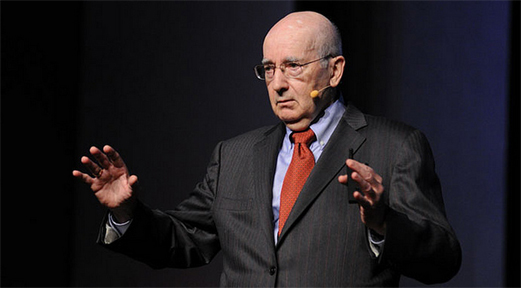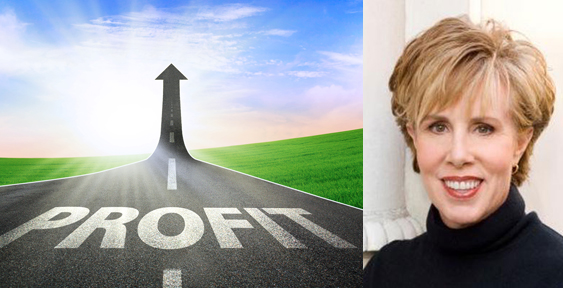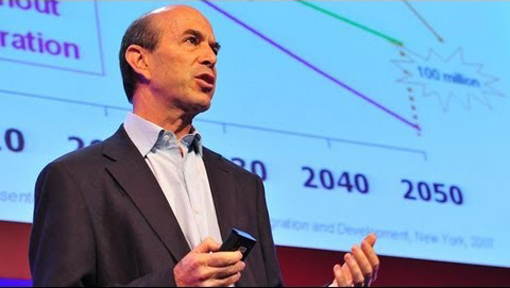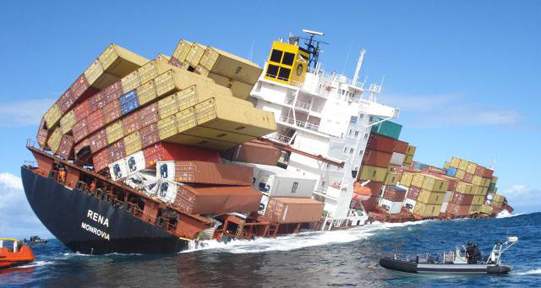
Rebuilding Democracy and Capitalism, with Dr. Philip Kotler
| When the two political parties running the American government are stuck in gridlock and refuse to work together on the mounting problems the nation faces...something is terribly wrong in America. | |
| |
 | Your upcoming book is entitled Democracy in Decline. What makes you say that democracy is in more trouble now as opposed to other moments in recent American history? |
 | When the two political parties running the American government are stuck in gridlock and refuse to work together on the mounting problems the nation faces – a decaying infrastructure, an extremely expensive college education, a health system with high and rising costs, a 15 percent poverty level, a minimum wage that does not support a livable life style – something is terribly wrong in America. It’s no wonder Germany, Canada, and the United Kingdom ranked ahead of the U.S. in the recent list of the best countries in the world.
Our two political parties in the past were able to negotiate and make concessions in order to pass needed legislation. Democratic Senator Ted Kennedy easily worked with persons on the other side to pass education and other bills. However, ever since Republican Senator Mitch McConnell stated in 2010 that “the single most important thing we want to achieve is for President Obama to be a one term president,” the two parties have stopped working together. The Republican Party was taken over by the new Tea Party that wanted no compromises. Both parties ended up attracting more extreme candidates. Today’s party paralysis doesn’t measure up to the worst moment in American history when the South was so exasperated that it left the Union sparking the Civil War, but we have moved into a new Uncivil War since the Republican Party supported Senator Ted Cruz’s 16 day shut-down of our government October 1-16, 2013 to stop any legislation or executive action that they didn’t like. |
 | What is the root cause of the decline in democracy? |
 | The root cause of democracy’s decline is the rising cost of getting elected in this country and what political aspirants have to do to get elected. The cost of the last Presidential election in 2012 was $6 billion. The estimated cost of the 2016 Presidential election is $9 billion. Each of the 17 Republican candidates in 2016 had to find a billionaire or several multi-millionaires to support their candidacy. Rick Santorum was supported by the billionaire Foster Friess, Newt Gingrich by casino magnate Sheldon Adelson, Scott Walker of Wisconsin by the Koch brothers, Ted Cruz by Robert Mercer, and Marco Rubio by Norman Braman.
This fund raising pressure has had a severe impact on whom our elected representatives are supposed to represent. Our government is organized as a Republic, not as a direct voting democracy. Our citizens don’t vote for each bill but vote for representatives who they trust will vote in their interest. But today’s elected politicians must give as much or more weight to the interests of their donors than to the people in their Congressional voting district. In 2012, there were over 13,700 registered lobbyists spending more than $3.3 billion annually in Washington, D.C. to influence and entertain our legislators. Most of them are financed by big business. So the consequences are: (1) our citizens have little influence on who gets elected, especially since the percentage of citizens who vote rarely exceeds 60 percent. (2) Congressional representatives and senators follow mainly the interests of big business and the wealthiest 1 percent. Instead of claiming that Congress runs the country, it is more correct to say that the major corporations and the wealthiest one percent run this country. Stated differently, the U.S. has moved from being a Democracy to becoming an Oligarchy. The definition of an Oligarchy is “government by the few.” |
| Voters need to be aware that both parties practice the Big Lie and repeat it over and over. | |
| |
 | According to 2014 data, 39% of voters identify as “independent”, 32% as “Democrat”, and 23% as “Republican”, but ultimately our general presidential election is shaped by primaries or caucuses that regularly bar independent voters. Given these numbers and the historically high unfavorable ratings of the two major parties’ presumptive nominees, has the two-party system reached a tipping point? |
 | Many times in the past American voters have had to choose between two candidates who are not favorably regarded. A voter would say “I am not going to vote” or “I am going to vote for my party’s candidate even though he or she is not my choice.”
Sometimes this disappointment leads citizens to launch a third party such as a Green Party, Libertarian Party, or Socialist Party. These “third parties” have no chance of getting voted in but they can affect which major party candidate gets elected. In the 2000 Presidential election, Ralph Nader ran for the Green Party vote and got 2.7 percent of the popular vote, possibly depriving Al Gore of the Democratic votes he needed to win the election against Republican George W. Bush. In virtually all Presidential elections, each party will do its best to portray the other party’s candidate as unqualified, unlikeable or dishonest. This is an almost intrinsic practice in elections. In the 2016 Presidential election, the Republicans have charged Hillary Clinton with lying about Bengazi and other matters: putting the country at risk by using her own email service and charging such high speaking fees to large corporations. These charges ultimately helped label her as untrustworthy. It doesn’t matter that Hillary was cleared by 11 different commissions of the Bengazi charge nor that several preceding Secretaries of State also had used their personal email service. The Democrats have responded by calling Donald Drumpf a racist because of his attacks on the judge who had Mexican heritage in the Drumpf University case, or have described him as an egotist or megalomaniac, or a snake oil salesman telling his followers that he can make America great again by being tough on our enemies and even on our allies. Voters need to be aware that both parties practice the Big Lie and repeat it over and over. What is badly needed are more fact checkers such as FactCheck.org or the CNN fact-checking team who grade claims to be true, partly false, or false. The two-party election system is partly saved by the 39 percent of the voters who identify themselves as independents. This is the group that decides on the winner. The independents decide who is the best and most qualified candidate or at least who is the lesser of two “evils.” |
| There are many feasible ways to make voting easier for our citizens. | |
| |
 | How could we restructure our presidential election process to make everyone’s vote count, regardless of party affiliation or geographical location? |
 | I would favor the following three measures:
|
 | How does the current level of gridlock in Washington D.C. compare to past dynamics between the two major parties? Has the media sensationalized this matter or are we truly at an unprecedented level of political discord? |
 | My impression is that today’s level of gridlock is the worst that it has been since the Civil War. The media treats gridlock as news-creating and selling newspapers. Instead of news media criticizing the intransigence of certain politicians who favor gridlock, they may sometimes represent these people as heroes trying to stop bad legislation from overtaking or destroying the country. |
 | You have said that elections are not enough to make democracy work. What else needs to happen? |
 | Elections take place in over 167 countries of the world. This does not establish that the country is a democracy. Russia, China and North Korea have elections but these countries are not democracies. The Economist Intelligence Unit (EIU) classified only 24 countries as full democracies and they cover 12.5 percent of the world’s population. Most of the others are flawed democracies or authoritarian regimes.
A full democracy is marked by (1) regular elections, (2) free assembly, (3) free speech, (4) a free press, and (5) the rule of law. The last four are missing in many so-called democracies. |
| Capitalism has produced such concentrated wealth in the hands of Big Business and the wealthy 1 percent that they can spend what they want to gain more power and more wealth. | |
| |
 | In your recently published book, Confronting Capitalism: Real Solutions for a Troubled Economic System, you talk about 14 major problems undermining capitalism – which ones are the most pressing and how can they be mitigated? |
 | Not only is our political system in trouble, but the same goes for our economic system. Recently, Yanis Varoufakis, Greek Minister of Finance, gave a Ted talk with the title “Capitalism is eating our Democracy.” This was my position in my 2015 book Confronting Capitalism before I ever heard Varoufakis speak. As a Ph.D. economist, I saw several flaws or shortcomings in our Capitalist economic system. I listed and analyzed fourteen of them, the main ones being the persistence of poverty, the growing inequality of income and wealth, the loss of a sufficient number of jobs, the fact that companies don’t cover the social costs that damage our environment, and the change from a manufacturing-oriented Capitalism to financial Capitalism.
For each shortcoming, I reviewed the major proposed solutions that an un-gridlocked Congress could apply. I wrote Confronting Democracy before Bernie Sanders came on the scene to run as the Democratic Presidential nominee. I was heartened by Bernie’s 20-plus issues and proposals to make America work better for more people. I was heartened by the great turnout of young people who cared deeply about his message about social democracy. The problem, however, is that Bernie is an idealist and Hillary is a realist. Bernie probably could not get most of his proposals accepted and Hillary can be more effective. Hillary can’t endorse all Bernie’s proposals because that would lose some independent voters and get Republicans to call Hillary a socialist too. In 2016, I published Democracy in Decline: Rebuilding It (Sage) to describe how our Capitalism injures our Democracy. Capitalism has produced such concentrated wealth in the hands of Big Business and the wealthy 1 percent that they can spend what they want to gain more power and more wealth. We lack a strong labor movement that would function as a countervailing force. We have to live with a Supreme Court 5-to-4 decision on Citizens United v. FEC allowing corporations to be seen as “persons” with the right to free speech and almost unlimited spending. We have to live with gerrymandering, gridlock, low voter turnout, and frankly very poor candidates who want to run for President, in a country where our most qualified and wisest people know better than to run for President and be slurred and abused. The very best potential candidates have chosen to sit out and live lives of higher pay and higher respect in other professions. |
 | How can developed countries reduce the wealth inequality gap? |
 | Of all the problems, the worst one is the growing gap in income and wealth between the rich and the poor. The middle class best represents our values as a nation and yet our middle class has been shrinking in size. The basic problem is an unfair sharing of the gains of productivity. Companies wish to keep wages as low as possible in order to be competitive on the world market, but they are quick to pay management very high salaries. The CEOs of many major companies take home an average pay of $10 million a year, which means that they are paid more than 300 times the average employee’s pay. The other senior managers also get fat pay packages that make American companies disadvantaged in competing with foreign companies whose management costs are much lower.
The growing pay gap between rich and poor could be reduced if we could improve our education system and enable more of our citizens to afford college. We also have created benefit programs such as food stamps, aid to dependent children, and others to support persons with lower incomes. Some countries such as Switzerland are introducing a Universal Basic Income (UBI), a basic income for all who need it. More practically, there are two basic solutions to reducing the growing income gap.
|
| We must seek the rise of more and different services that require a human touch and cannot be replaced by robots or artificial intelligence. | |
| |
 | There has been a lot of talk about the threat of robots replacing human workers. How can there be greater job creation in the face of growing automation? |
 | Companies always search for ways to reduce costs and labor can be a major cost in running a factory. Many machines have been developed that can do the work of humans at a much lower cost and often with more precision. These machines go under the name of automation or robotics. We can imagine a new factory run only by one technician and a dog; the technician would manage a set of dials and the dog would keep the technician awake.
The digital age is disrupting lives beyond those persons working in our factories. Digitalization has introduced a whole new way of forming and delivering certain products. Our books, newspapers, magazines, photos and videos are all reducible and expressible in shippable packages of dots and dashes. The dematerialization of paper, ink, film, etc. has occurred. Many human tasks can be taken over by artificial intelligence software. All said, many familiar jobs will become obsolete. Of course, new jobs will be added by people who have the skills to make and manage these new digital products and services, but most likely the number of new jobs created will not be equal to the number of jobs destroyed. The major hope lies in the creation of new or expanding industries or activities that are labor intensive. We must seek the rise of more and different services that require a human touch and cannot be replaced by robots or artificial intelligence. Short of these new industries and service activities, the working hours of existing jobs are likely to be cut down. If this cuts incomes further, this would mean a move to a lower standard of material living for more people. |
 | What is a company’s “social cost?” |
 | Every company, in the course of doing its work, may do some harm to the environment. A chemical company may dispose of chemicals in a nearby lake; a construction company may not clean up the mess; a timber company may fail to replace the soil and replant timber. If pollution and other social costs are not covered by companies, the government and ultimately tax paying citizens have to cover the cleanup costs. Economists would like these “net externality costs” to be “internalized” and carried by the companies causing them.
========================================================= |















